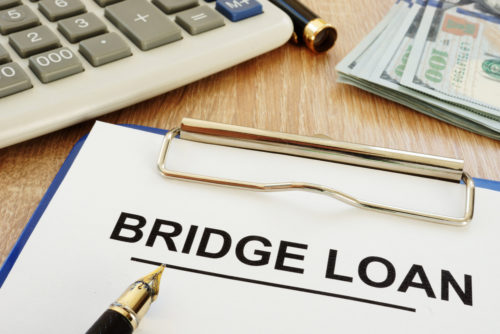If you’re in the market for a new home and need to make a purchase before you move out of your existing residence, a bridge loan can help. This short-term loan is secured by your existing home and is designed to help you “bridge” the gap between the cost of your new home and the balance on your existing mortgage. Essentially, you’re borrowing money for a downpayment on your new home. A bridge loan serves as an intermediary loan that helps the borrower finish paying off an old mortgage while they acquire a new one. Sometimes, a bridge loan can be used for the construction costs of a new home. Learn more about how bridge mortgages work and if they’re a feasible option for you.
Table of Contents
Bridge Loan Versus HELOC
A home equity line of credit (HELOC) often has better interest rates than a bridge loan, but HELOCs don’t offer all of the same perks. Plus, HELOCs are often not available to borrowers who have a house on the market. Because of this, homebuyers often wait to sell before they buy again. These aren’t the only differences between bridge loans and HELOCs, though.
A HELOC could be a quicker and more economical option, especially if you’ve built up a lot of equity in your home. Costs associated with obtaining the loan could be minimal, if not zero, and the interest rate is typically based on your credit rating, which makes obtaining a decent interest rate easier. HELOCs are often viewed as the path of least resistance, assuming that you have enough equity and good credit. The drawbacks of a HELOC are that you’ll have to carry all three payments, including the mortgage and HELOC on your current home, as well as the mortgage on your new home.
Bridge loans allow you to borrow against the equity in your current home while still being able to sell it. Unlike traditional loans, including a HELOC, monthly payments aren’t required for bridge loans. Instead, the balance and any interest accrued are due at the time of the sale. Bridge loans can be more costly overall, as they tend to carry an interest rate that’s significantly higher than those commonly found in a 30-year fixed interest rate mortgage. To make the choice that’s right for you, decide whether or not you can balance three payments. If you can, a HELOC may be right for you, as this is the least costly option; however, it’s the most difficult to manage. Bridge loans are more costly, but offer you more flexibility when it comes to your finances.
Pros and Cons of Bridge Loans
Bridge loans are a great option for people who are between homes or looking to invest in a business property. Bridge mortgages seem to offer borrowers more good than bad, but they do have drawbacks.
Pros
- The main benefit of bridge loans is the flexibility that comes with them. You can purchase a new home and list your old one without any restrictions. This flexibility is useful in instances where you can’t afford a down payment for a new home. It is also helpful in situations where sellers in your area won’t accept contingent offers, or you prefer to secure a new home before listing your current one on the market.
- Another benefit of bridge loans is that they make buying and selling your home a faster and less expensive process. You can pay for any immediate expenses associated with selling your home, close faster on properties, make renovations, or buy more time to find new tenants for the space you’re trying to sell. This lessens the stress of buying and selling your home, too.
- There is no contingency to sell your previous home. Some bridge loans are flexible and don’t require monthly payments for a few months. Your payments might be interest-only or deferred until you sell your current home. While payment is deferred, you have no financial responsibility to pay back the loan. Plus, the lender cannot seek compensation for the loan if the value of your property doesn’t cover the balance of the loan.
Cons
- The flexibility that makes bridge loans so appealing also contributes to one of the biggest disadvantages of this kind of loan. In the end, a bridge loan can be more expensive than a HELOC. You could end up paying higher interest, with rates between 0.5-1% more than a standard 30-year fixed-rate mortgage.
- Because of the flexibility of these loans, lenders aren’t too forgiving when it comes to late payments and the fees associated with them. Because the loan is short-term and you’re responsible for selling your home at a significant cost, the bank expects payments to be made on-time and in-full.
- To obtain a bridge loan, you have to qualify to own two homes. In other words, you must be in good financial standing for the bank to agree to lend you two mortgages at once. In addition to qualifying, it can be stressful to have to make two mortgage payments while the bridge loan is accruing interest.
- Bridge loans can end up being more expensive than you might have planned. There are additional fees, such as appraisal and closing costs, that you are responsible to pay.
- Your loan-to-value (LTV) rate is limited to 80%. This means you’ll need more than 20% equity to yield enough money for the house you want.
Ultimately, deciding whether to take out a bridge loan is a matter of knowing that market conditions are favorable. If you can expect to sell your current home quickly and for a decent price, a bridge loan might be a good idea. Do your research and talk to a real estate agent before opting for a bridge loan.
Image Source: https://depositphotos.com/





